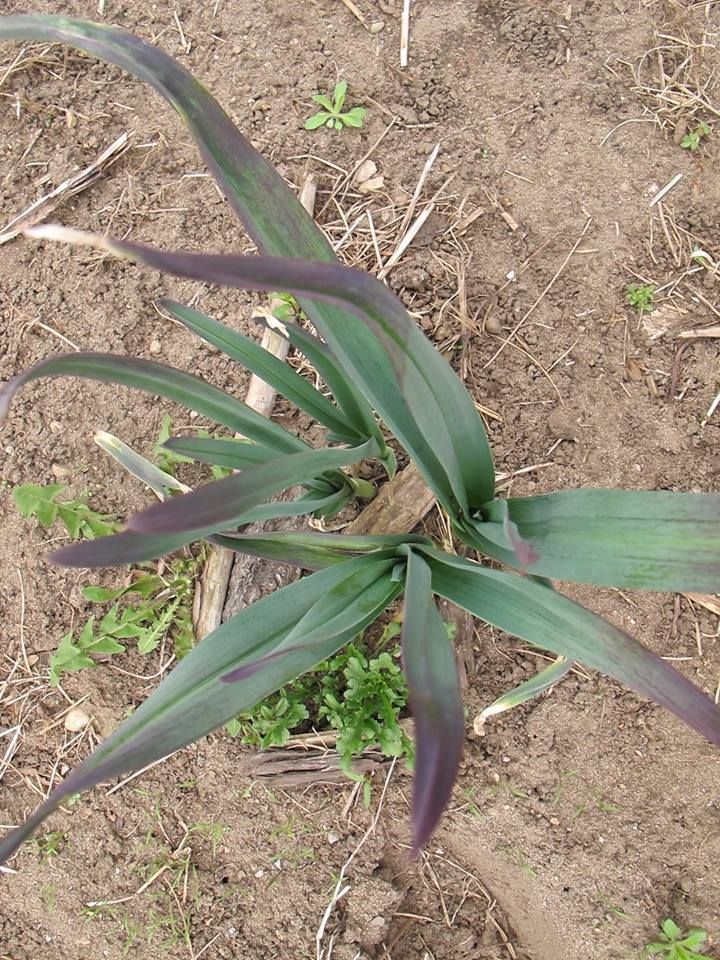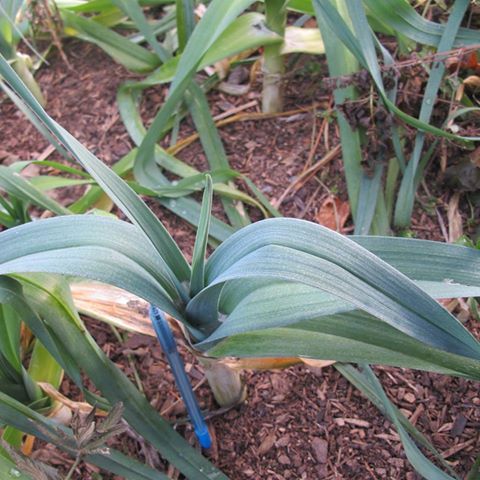|
|
Post by ottawagardener on Dec 12, 2014 23:06:59 GMT -5
I've seen several references to this so would love to hear about other people's work.
I've crossed Long Island Seed Project's blue select leek mix survivors that tended to offset (forming large leeks again) with Oerprei. I spent the first couple years selecting for blue coloration and winter hardiness in the LISP and then, after noticing I had a patch that offset after flowering quite vigorously for many years in a row, crossed with Oeprei. I only have the f1s growing now.
Tell me about yours.
|
|
|
|
Post by Al on Dec 13, 2014 16:09:20 GMT -5
I was fascinated to read of the 'bunching leek' Oeprei.
I hope to get hold of this, I guess it originates in Holland so should find it this side of the Atlantic.
I live a couple of miles from Musselburgh in East Lothian where there are acres of leeks, so I should probably be content to grow Musselburgh leeks. I find leeks from seed pretty satisfactory but am attracted to perennial & offsetting varieties, lifting & replanting little & often might spread the harvest compared to seed grown crops which tend to mature all together.
I have some quite big offset leek bulbs which I have planted in pots & a Babington, also a flower covered in leek grass / pips. So hope to get some vegetatively reproduced leeks alongside the seed raised plants which might extend my leek season.
|
|
|
|
Post by orflo on Dec 14, 2014 4:10:32 GMT -5
It's oerprei, with an r before the p, which means leek of ancient times. Lots of people grow it over here, it's one of the few 'old' varieties that seem to last. It can be used as greens, which is the traditional way to use it, cut of the green top part and use it as leek, or it can be used, after it disappears in August, as some sort of 'Perlzwiebel' (it's unclear whether this is actually Perlzwiebel or not), the small garlic like bulbs are eaten or pickled or ...The taste is much milder than garlic, and is more comparable to elephant garlic. The plants don't grow as big though...
|
|
|
|
Post by ottawagardener on Dec 14, 2014 9:09:08 GMT -5
Spelling corrected.
|
|
|
|
Post by ilex on Dec 14, 2014 9:16:48 GMT -5
My puerro de bulbo flowered last summer, and I left some normal leeks nearby to get some crosses. I even crossed some myself, but didn't mark the flowers ( very clever on my part). It would be great to increase the size of puerro de bulbo, or get it's bulbing capabilities into bigger leeks.
Also tried to select for perennial leeks from normal leeks for a few years but wasn't very successful. I want them to multiply more, I'm getting something like 2-4 per plant. Too slow. I want 10.
I see lots of potential to these perennial leeks.
|
|
|
|
Post by ottawagardener on Dec 14, 2014 12:12:10 GMT -5
Pretty typical offsets for the LISP blue select that I am using:  Here is the f1 cross first year. Leaves are floppy because this is just after a frost:  |
|
|
|
Post by mybighair on Dec 14, 2014 14:31:03 GMT -5
I was just about to message you regarding oerprei Frank. I was wondering if it was the same thing as pearl onions, but it looks the answer is no one is sure. I'll have to try and track it down.
|
|
|
|
Post by ilex on Dec 15, 2014 3:11:06 GMT -5
If I remember well, at a germplasm institution they had over 20 perennial leeks from Portugal that were not propagated by seeds. Just looking how normal leeks try to ofset or make bulbs, I'm sure they were quite common in the past.
Wild leeks are common here, so I guess crosses are not that rare. They make small pearl bulbs. Leeks are thin, with great flavour, and lots of fiber.
|
|
|
|
Post by orflo on Dec 15, 2014 5:23:37 GMT -5
I was just about to message you regarding oerprei Frank. I was wondering if it was the same thing as pearl onions, but it looks the answer is no one is sure. I'll have to try and track it down. Graham, nice to read you...! It's very confusing, the perlzwiebel that is offered commercially in jars today is mostly allium cepa, harvested very young.These are also called 'zilveruitjes', 'silver onions' which is closer to the correct reference, however, sometimes you can still find them as 'parelui', pearl onion. There used to be a German company that offered the 'true' perlzwiebel, they claimed is was allium ampeloprasum, and the bulbs were also round, rounder than the ones from oerprei. However, the mansfeld reference and picture give these somewhat more flattened bulbils, and a growth habit that seems to be a cross of babbington leek, oerprei and elephant garlic. mansfeld.ipk-gatersleben.de/apex/f?p=185:46:1675560916764::NO::module%2Csource%2Ctaxid%2Cakzname:mf%2Cbotnam%2C208%2CAllium+ampeloprasum+subsp.+ampeloprasum+Pearl-Onion+GroupSo, possibly pearl onion was used for different varieties in the past, or even different species? |
|
|
|
Post by blueadzuki on Dec 15, 2014 7:14:16 GMT -5
I suspect there is a also a lot of label error and a fair amount off out and out deception. I read somewhere that there are exporters in China who are now selling jars of "Pearl Onions" and "Cocktail Onions" that are in fact bulbs of rakkyo ( Allium chinense). I'd say in this day and age ANY commercial labels claim as to species must potentially be taken with a grain of salt (or in this case, a splash of brine  ) |
|
|
|
Post by Al on Dec 15, 2014 9:36:24 GMT -5
There is definitely some 'out & out deception' in labeling of produce. Look at the so called banana shallots which are actually an onion grown from seed, Zebrune or Cuisse de poulet du Poitou. Albeit an onion with a shallot like flavour, possibly a cross. It may not matter that much if what is supplied conforms to the common expectation for that label. Except eventually people forget what a shallot actually is, this might be getting too deep now! The French have tried to define the authentic shallot, but more generic terms like pearl onion seem to be available to anyone selling little white pickled alliums.
I understand pickled Rakkyo is pretty tasty & not an inferior product, but unknown in many western countries. Re-labeling Rakkyo as pearl / cocktail onions might be a smart marketing ploy for Importers.
Those LISP blue leek crosses look pretty good Ottawa.
|
|
|
|
Post by ilex on Dec 15, 2014 12:20:51 GMT -5
Puerro de bulbo:  |
|
|
|
Post by 12540dumont on Dec 15, 2014 14:03:56 GMT -5
Ilex, now that's a leek bulb! Very pretty.
Ottawa, Some years ago I got a package of Belgium Breeder's Leeks by Lieven. I think they still carry them at Wild Garden Seed. "F7 population, a wondrous blend of leek colors, leaf widths, shaft lengths and diameters".
Some of these make bulblets/offsets.
Your blue looks very much like the Bleu de Solaise. The offsets are a real bonus for me. When I harvest leeks, if there's offsets, I put them right back in the garden. A few years ago, when we did the onion/leek trials, a number of offsets and seeds got left behind and still make their onion leeks in that area. We had to fallow that area due to drought. Last year we had few onions and few leeks. I'm hoping with the rain I'm seeing now that the beds will have received enough moisture that I will be able to return to leeks and onions.
|
|
|
|
Post by templeton on Dec 15, 2014 21:34:56 GMT -5
I've been fooling with some leek mass crosses, but have been a bit slack with my labelling. Two years ago I put in generic leeks from a supermarket punnet of seedlings, and varying small numbers of King Richard, Jaune de Poitou, some gifted perennial leeks offsets from two donors (thanks Rowan) Leivens F7 from WG, and some others that i cant remember without my notebook ( on holidays atm). Seed got haphazardly collected, (mostly plant to bag), and resown (mostly bag to row) this year. I've resown a better labelled patch this season of most of these as well, with some Giant Bulgarian (that AllyH picked up for me in the UK earlier this year). A few wild plants of Russian Garlic got transplanted from the railway line in Kangaroo Flat, but I'm not sure these are fertile. I'll be collecting seed from the original mass cross growout in a few weeks, selecting from the most robust plants.
The distinction between summer and winter leeks seems mostly moot here, no snow, a few mild frosts, and leeks grow through the year. I didn't notice any variation in Leivens leeks from my WG batch.
|
|
|
|
Post by templeton on Dec 15, 2014 21:44:31 GMT -5
Selection from these MX F1s presents some problems. I've probably got too little space to actually do this with much chance of making good selections.I mostly sow leeks (or plant offsets) in late summer, grow them and eat small ones through winter and early spring, before they flower. Keeping water up through summer is just too hard. And harvesting to sample for kitchen quality delays seed production considerably...
T
|
|